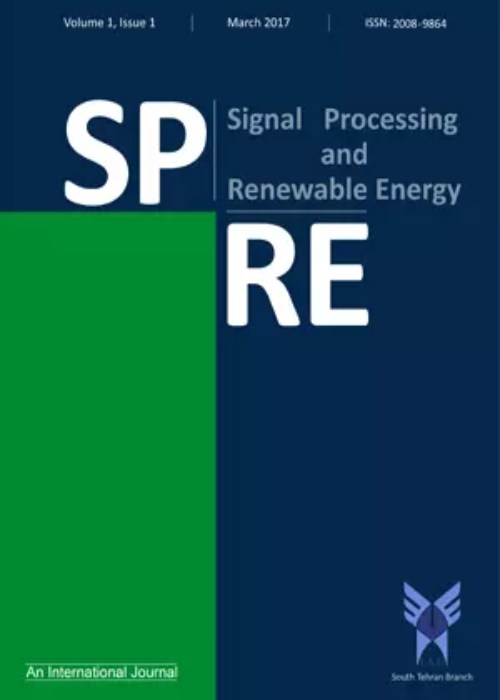فهرست مطالب
Signal Processing and Renewable Energy
Volume:1 Issue: 4, Autumn 2017
- تاریخ انتشار: 1396/09/10
- تعداد عناوین: 6
-
Pages 1-8An Advanced Encryption Standard (AES) algorithm is one of the most popular and most commonly used encryption algorithms. This algorithm can be implemented on microcontroller chips and FPGAs with various specifications. Also, the goals of implementing this algorithm are varied according to the application and requirements. In this paper, a project has been given that output very high data transfer rate equal 192 Gbps on the FPGA of the Virtex-7 (XC7VX330T-3FFG1157) from Xilinx. The extracted results of the implementation of the algorithm in the ISE 14.7 software show the maximum achievable clock frequency 500 MHz, with the parallel implementation of than three AES algorithms cores on a chip, higher speeds are also available.Keywords: Encryption, AES algorithm, High-Speed AES, Rijndael
-
Pages 9-25
This paper presents a new method based on empirical mode decomposition and Hilbert transform for detecting islanding from non-islanding events in distributed generations. In this paper, the empirical mode decomposition is used to separate out intrinsic mode functions (IMF) from non-stationary power signal disturbance waveforms. Then, the Hilbert transform applied on all the IMFs to extract the instantaneous amplitude and frequency components. The required index is extracted from the energy spectrum density of the signals that introduced as U1, U2, and U3 and we can detect islanding events with high accuracy, low cost and high speed in distributed generations.
Keywords: Distributed Generations, Empirical Mode Decomposition, Hilbert Transform, PowerSpectrum Density, Power Mismatch, Islanding Detection -
Pages 27-35
In this paper, a variety of techniques to detect icing and de-icing on elderly wind turbines are specified. Wind turbines are often used in cold weather and they are subject to freezing. The vast majority of freezing is created on the turbine blades. This reduces the performance of wind turbine and also creates instability loads on the blades aerodynamic, fatigue and Health and increases the risk. Wind turbine associated with the stop at the end. Turbine Stop loss is a significant portion of wind energy. Dealing with the freezing and defrost systems is an aim to optimize the impact of weather on the wind turbines. Many active and passive methods have been considered for this issue and they are developing day by day.
Keywords: Wind turbine, icing identifying, De-icing, Anti-icing -
Pages 37-50The IP Multimedia Subsystem (IMS) is a platform for the exchange of multimedia communications that was proposed by 3GPP as of the year 2002. The 3GPP proposal called for the integration of mobile cellular networks and internet technology using a completely IP-based structure. The IMS uses the protocols defined by the IETF, such as SIP, RTP and others. SIP is the backbone of the IMS network, where it is used for signaling and multimedia services control. However, security vulnerabilities are inherent in such integration. When the IMS architecture is opened for easy network access and the use of SIP, it is far more vulnerable to SIP flooding attacks. This has presented a significant security problem in new networks. In the presented method for detection, network traffic is captured in two phases, being the training phase and the test phase. The distance between the probable distributions of SIP messages in these two phases is then measured using the Kullback-Leibler divergence. Then, an adaptive threshold is defined for the Kullback-Leibler divergence which, when passed, means that an attack has occurred. The adaptive threshold is accounted for by the use of a Triple Exponential Moving Average (TEMA), and the performance of the presented detection method in various situations of normal traffic and massive attacks is evaluated. The parameters α, β, ε, and γ are used for estimating the threshold and setting a safe margin for authorized traffic. In addition, the effect of changes of the estimate and setting parameters is evaluated.Keywords: IP Multimedia, flooding attack, adaptive
-
Pages 51-63In this paper, two protective devices, recloser and cutout fuse, are placed simultaneously. Indeed, main contribution of this research is considering Distribution Generation (DG) placement in this problem. The multi objective function has been formulated based on minimizing power loss and maximizing reliability. Selection of reliability indices has been performed based on a compromise between customer satisfaction and seller. This problem is solved by Particle Swarm Optimization (PSO) algorithm and tested on the part of practical distribution system. The reliability indices are System Average Interruption Duration Index (SAIFI), Cost of Energy Not Supplied (CENS), System Average Interruption Frequency Index (SAIFI) and Momentary Average Interruption Frequency Index (MAIFI). Simulation has been performed in part of practical distribution system by introduced several scenarios and cases.Keywords: Protection design, particle swarm optimization algorithm, Reliability Improvement, Distribution network
-
Pages 65-69In this paper a method to design tapered slot antenna (TSA), a member of ultra-wideband (UWB) antenna, is presented. The proposed method is related to impedance matching of input and free space intrinsic impedance by Butterworth method. By this method, curve fitting converts step impedance to optimized curve and this optimized curve and its symmetry create Vivaldi antenna. The fractional bandwidth (FBW) of the antenna by the proposed method is 155% which is more than the methods of Chebyshev and attenuation. A prototype of this antenna is fabricated and simulation and measurement results are in good agreement.Keywords: tapered slot antenna, ultra wide band, curve fitting, Vivaldi antenna


